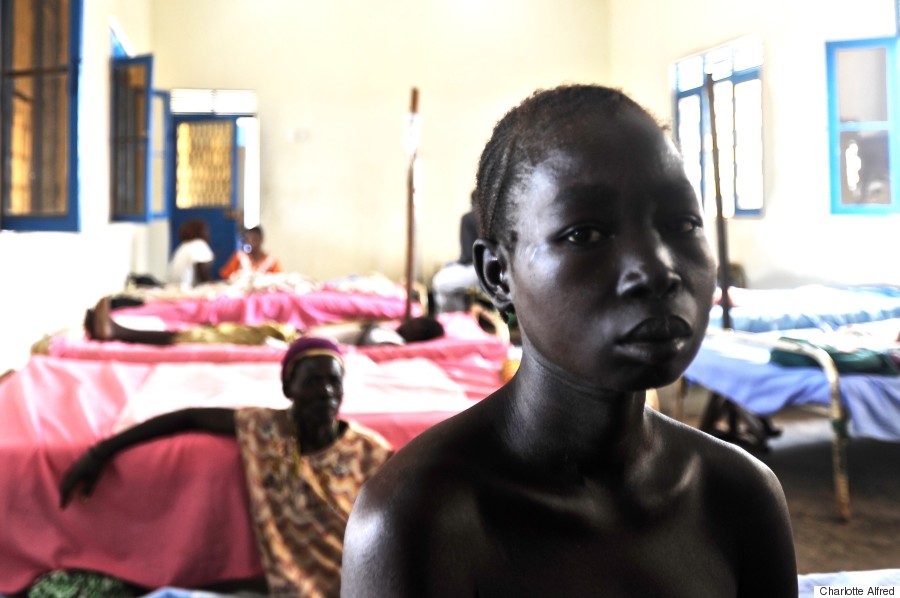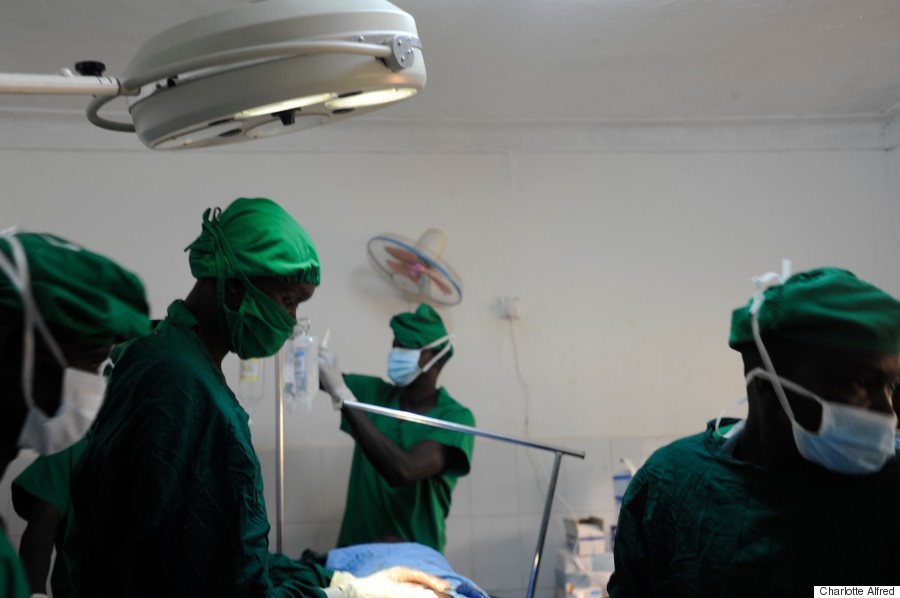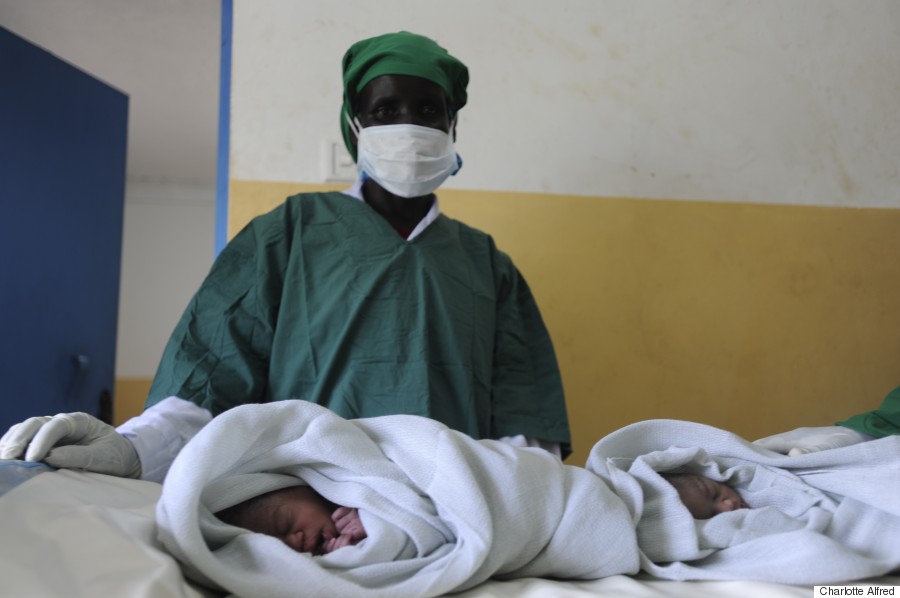KUAJOK, South Sudan — After 48 hours of agonizing labor pains, Nyibol Garang’s family still refused to bring her to the hospital. So the 23-year-old woman set off by herself — mid-labor — to walk four hours to the only major hospital in the state of Warrap in South Sudan. The hospital is a small cluster of one-story buildings in the state capital of Kuajok, crammed with rickety beds and mattresses lining the floors. It treats more than 100 patients a day from all over the state, which has a population of nearly 1 million people. When Garang arrived at the hospital on a Friday in…
KUAJOK, South Sudan — After 48 hours of agonizing labor pains, Nyibol Garang’s family still refused to bring her to the hospital.
So the 23-year-old woman set off by herself — mid-labor — to walk four hours to the only major hospital in the state of Warrap in South Sudan.
The hospital is a small cluster of one-story buildings in the state capital of Kuajok, crammed with rickety beds and mattresses lining the floors. It treats more than 100 patients a day from all over the state, which has a population of nearly 1 million people.
When Garang arrived at the hospital on a Friday in late May, doctors told her she would need to have a cesarean section or her baby would not survive. Garang said she couldn’t have an operation without her husband’s permission. But when her husband finally joined her at the hospital the next morning, he refused.

In this conservative, rural society, women have little say over their own bodies, and many people are fearful and suspicious of modern medicine. “If you decide to stay at the hospital, whether you live or die, you can never return home,” Garang’s husband told her.
Garang — at this point three days into her labor — acquiesced and began the walk home. A nurse from the hospital came running down the road after her. She appealed to Garang to choose her life, and her child’s life, over her husband’s wishes.
“I agreed, because I don’t want to die,” Garang told The WorldPost, as she recovered in Kuajok’s maternity ward a day after the operation. “And if I have to die, I’d prefer it to be at the hands of the doctors rather than lying at home.”
After Garang agreed to let doctors operate, they discovered why her labor had been so difficult: She was pregnant with twins. She’d had no idea, and neither had the doctors, who couldn’t afford an ultrasound machine. Once Garang’s twin girls were safely delivered, a procession of singing, ululating nurses and well-wishers carried the newborns into the maternity ward.
See more photos on The WorldPost of the medical staff and patients at the Kuajok hospital’s maternity ward.

South Sudan has the highest maternal mortality rate in the world — 2,054 deaths per 100,000 births, according to the last national survey in 2006. No other country comes close: The next two highest-ranked countries, Somalia and Chad, have maternal mortality rates half as high as South Sudan’s. And aid workers at several agencies told The WorldPost that they believe the official numbers actually understate the situation in South Sudan, since many women die in their homes or en route to hospitals, where their deaths go unrecorded.
When South Sudan won independence from Sudan in 2011, four years ago this Thursday, there was great hope around the world that these kinds of devastating figures would become a thing of the past. With the promise of peace and an influx of aid, it seemed this remote and war-torn region would finally have a chance to remedy its chronic lack of infrastructure and services — issues that have contributed to the country’s sky-high rates of malnutrition and illiteracy, among other problems.
Just two years later, those hopes were dashed by violence, as conflict between the new nation’s leaders exploded into a civil war that is still wrenching the country apart along ethnic lines and giving rise to a series of gruesome atrocities.
Giving birth, already a dangerous prospect in the region, is becoming even more risky. According to Medicins Sans Frontieres, some 90 percent of South Sudanese women do not give birth in formal medical facilities. Expectant mothers already had to contend with a widespread aversion to modern medicine, as well as the prospect of a long, difficult journey to one of the few health facilities in the country. Now they also have war to deal with.
Mistrust in the government’s medical system runs deep in South Sudan, a legacy of years under Sudan’s repressive policies. In the past two years, public perception of the medical system has suffered even further, due to dwindling resources and tensions with unpaid and overworked staff, Suzie Francis Paul, a World Health Organization medical officer in South Sudan, told The WorldPost.

Even if they want to seek medical help, millions of South Sudanese are trapped by fighting and more than 2 million are on the run for their lives.
“People are constantly moving for their own security,” Martina Fuchs, founder of the Real Medicine Foundation, told The WorldPost.
Fuchs’ foundation supports a midwife training program in Juba, the capital of South Sudan, that’s helped boost the number of registered midwives in the country from from just eight in 2012 to 85 this year. But efforts like these can only go so far in the midst of war. “We’ll start treating pregnant women in one place, and by the next morning they are gone,” Fuchs said.
South Sudan had little in the way of a health system before the war started, and as a result it has some of the worst health statistics in the world. Some 10 percent of South Sudanese children die before their fifth birthday. The country’s average life expectancy is just 55. South Sudan has approximately one doctor per 65,000 people — in the U.S., the figure is about one doctor for every 400 people — and an estimated 80 percent of medical services in the country are provided by international organizations.
Now, the war is straining even these scant resources. In the worst-hit areas, two-thirds of the health facilities have closed or are working at only partial capacity, according to the United Nations Population Fund. Last month, the government announced a deadly outbreak of cholera, the second since the war began. And on Friday, the International Committee of the Red Cross said that 11 patients who needed surgery had died at a South Sudanese hospital the ICRC supports, after doctors and nurses fled an attack on the facility.
“War worsens everything,” Barack Malith Atem, a 55-year-old medical director at the Kuajok hospital, told The WorldPost. “Even if something was already at a low standard before the war, it has got even worse.” The hospital, unable to get funding from the government, is supported by international donors, including the aid group World Vision, which funded and organized The WorldPost’s reporting trip to South Sudan. Resources are stretched thin as the battles rage on.
The hospital at Kuajok has been flooded with the casualties of war. The facility is short on medical staff, since would-be recruits are fearful of the state’s proximity to the conflict — or, if they belong to certain ethnic or linguistic groups, they’re afraid of being targeted themselves. In late May, unidentified militia groups looted delivery vehicles bringing beds and other critical supplies to the hospital. And health workers are struggling to treat and counsel a growing number of rape survivors amid the influx of soldiers and militia fighters to the area.

“Anyone who has a gun stops thinking about the dignity of others and thinks he can do whatever he likes,” Atem told The WorldPost. “War creates a lot of dangers for women … When their husbands go to war, or have to flee because their ethnic group is targeted, women are left alone with the children, and they can’t feed them or treat them when they are sick. Even some of their young children are going to fight in the war.”
Both sides in the conflict have been accused of using rape as a weapon of war and forcibly recruiting child soldiers. The region has a long history of militias abducting children for battle or pressuring families to allow their children to fight.
“Mothers are suffering a lot,” Atem said. “They see that this is a senseless war, that there is no reason for their husbands to die, for their children to die. They are powerless and traumatized.”
“We often see women coming for treatment very late, and without any relatives,” Okello Arngod, a 35-year-old senior medical officer at the hospital in Kuajok, told The WorldPost. “More people are displaced or very poor and they don’t have means to get to the hospital in time.”
Apieu Gatluak, 28, got lucky. Her husband, a government soldier, is frequently away at war. But he was on leave in late May, which meant he was there when Gatluak gave birth to the couple’s son, Ayany, at their home. He was also able to take her and Ayany to the Kuajok hospital on the back of his bicycle when the baby’s umbilical cord became infected. If her husband hadn’t been there, Gatluak says, she’s not sure what she would have done.
“Since the war broke out, I have been completely isolated,” Gatluak told The WorldPost at the hospital. “I am from a different state and different tribe, and when the fighting started, people began to pretend that they don’t know me.”
Gatluak had already had three children, but she came to the hospital for the first time during her pregnancy with Ayany because of complications caused by bouts of typhoid, malaria and syphilis. The prevalence of disease and malnutrition makes pregnancy even more dangerous for South Sudanese women. “Pregnancy adds so many demands to your body due to the growing baby,” said Fuchs. “Malnutrition and disease take resources away from the pregnant mother and for the baby to grow.”

The war has made things even worse. The number of severely malnourished children has doubled since the fighting began. Nearly 200 people have died in cholera outbreaks, and malaria rates are soaring.
Another hidden cost of war is the additional pressure on families to marry off their daughters at a young age, in a country where child marriage is already widespread. Almost half of South Sudanese girls are married before they are 19 years old, according to government estimates. Doctors and aid workers told The WorldPost that the practice appears to be on the rise due to war, although there is little reliable data on the topic.
“It is becoming increasingly dangerous for children as most families do not have enough resources to feed their children,” said Masumi Yamashina, a child protection specialist for UNICEF in South Sudan, in an email to The WorldPost. “Unfortunately in these circumstances, child marriage is seen as a coping mechanism by the family — which is obviously not good for the girl — because it reduces the numbers of mouths to feed and also brings cattle from the husband.”
Fuchs likewise noted that child marriage tends to be the recourse of people with few other options.
“Child marriage has to do with despair,” she said. “People are trying somehow to get their children taken care of.”
When girls are married off young, however, that can lead to a whole other suite of health problems. Put simply, children’s bodies are not equipped to undergo the trauma of childbirth. Girls ages 14 and younger are five times more likely to die while giving birth than women in their 20s, according to the United Nations’ Children’s Fund. The problem is especially acute in South Sudan: According to the U.N., South Sudanese girls are three times more likely to die in childbirth than to enter high school. Nearly half of all girls ages 15 to 19 in the country are married, and at the Kuajok hospital, doctors estimate that child pregnancies account for about one out of every 12 deliveries they carry out.
“I was so afraid when I found out that I was pregnant, because everyone told me if you get pregnant young you will die,” Anger Tong, a young mother at the Kuajok hospital, told The WorldPost. Tong, who told doctors she was 18 years old, gave birth to a daughter, Achol, in late May. She quietly mentioned that her older sister had died in childbirth.

Tong came to the hospital with post-natal hemorrhaging, but she was saved by a blood transfusion from her brother. “I don’t want my daughter to be like me,” she told The WorldPost. “I was very sorry to be pregnant, because I didn’t want to stop school.”
“My daughter should be educated so she can make a change in her life,” she said.
The staff at the Kuajok hospital take on many roles in trying to make childbirth safer. They offer family planning advice, rape counseling and antenatal care, and they often act as mediators for women seeking treatment against their families’ wishes. “In our society, women don’t have rights, not even to ensure their own health,” Atem said. But Garang’s decision to have a C-section gave him hope. “It’s her life,” he said, “and she has the right to decide.”
Garang is only the ninth woman to have a C-section at the hospital. Arngod, the senior medical officer, has taken photos of each woman, and plans to hang them in a small hall of fame at the hospital once there are 10, in a tribute to the women’s bravery.
“One day,” he said, “they’ll be remembered as the very first 10.”

More from The WorldPost on South Sudan:
– Meet The South Sudanese Farmers Who Want To Feed Their War-Torn Nation
– These Girls Dream Big Despite Hunger, Discrimination And Conflict
– This War Is Dramatically Escalating, But Remains Hidden From View
– Political Exiles’ Return To South Sudan Raises Cautious Hopes For Peace
– Life Inside A UN Base Where Thousands Shelter From South Sudan’s War
The reporter traveled to South Sudan on a media trip organized and funded by the aid group World Vision.
— This feed and its contents are the property of The Huffington Post, and use is subject to our terms. It may be used for personal consumption, but may not be distributed on a website.
This article –
How South Sudan’s Conflict Is Killing Women Far From The Battlefield




















